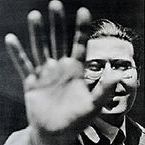Born in Bácsborsod, Hungary on July 20, 1895, László Moholy-Nagy first expressed his creative interests through writing. He contributed short stories to the Hungarian periodical Jelenkor (Our Age), published by the aesthetician Iván Hevesy. While training to be a lawyer at the University of Budapest, Moholy-Nagy was drafted into the Austro-Hungarian Army and called to the Russian front during World War I. It was during this period that Moholy-Nagy began to experiment with visual art, making over 400 drawings on military-issued postcards.
After World War I, Moholy-Nagy returned to Budapest where he became active in the Hungarian avant garde, aligning himself with the circle of intellectuals and artists led by Lajos Kassák. As Moholy-Nagy began to think about art in increasingly social and revolutionary terms, he moved from the postcard genre into larger portraits and landscape drawings. These pieces, energized by Moholy-Nagy?s forceful, vigorous method, show the hand of a confident and maturing artist at ease with the technical demands of his chosen medium. He borrowed freely from the stylistic lead of his friend and mentor, Lajos Tihanyi, yet succeeded in creating a body of work distinctly his own in its dynamic and metaphorical use of line.
This portrait series coincided with a number of political upheavals in Hungary after the war. During the rise to power of the Horthy government, Moholy-Nagy and other members of radical or revolutionary groups left Hungary in a self-imposed political exile. Many landed in Vienna, where Moholy-Nagy spent six weeks working with Kassák and the continued publication of the journal, MA (Today). Moholy-Nagy then moved on to Berlin, where he eventually settled before joining the German Bauhaus School in Weimar. Moholy-Nagy?s first year in Germany signaled a turning point in his maturation as an artist. Although he continued to sketch a few representational portraits of friends, he essentially abandoned this style for abstraction, turning to the ?machine aesthetic? as a universal form for expressing the visual complexities of modern life. His work from this transitional period testifies to the flurry of intellectual and artistic activity which spurred Moholy-Nagy?s transformation into the master teacher known as a ?painter of light.?
